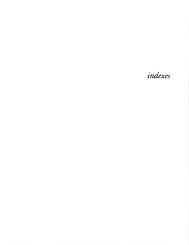The Singing Neanderthals: the Origins of Music, Language, Mind ...
The Singing Neanderthals: the Origins of Music, Language, Mind ...
The Singing Neanderthals: the Origins of Music, Language, Mind ...
You also want an ePaper? Increase the reach of your titles
YUMPU automatically turns print PDFs into web optimized ePapers that Google loves.
trast from a continuum <strong>of</strong> complexity supported to a<br />
lesser or greater extent by culture. Specifically, <strong>the</strong>re is<br />
a conservative ‘natural’ default that can be modified,<br />
under certain kinds <strong>of</strong> cultural pressure, to create and<br />
sustain a secondary level <strong>of</strong> signal complexity, which<br />
will fall away again if <strong>the</strong> cultural pressure reduces<br />
(Wray & Grace in press). Although we <strong>of</strong>fer this model<br />
in relation to language, <strong>the</strong>re is no difficulty, I think,<br />
in extending it to music.<br />
<strong>The</strong> key impact <strong>of</strong> all <strong>of</strong> this is that I would<br />
hesitate to develop an argument about <strong>the</strong> origins<br />
and characteristics <strong>of</strong> natural musicality on <strong>the</strong> basis<br />
<strong>of</strong> how people appear to use learned musical skills.<br />
<strong>The</strong>se I would ra<strong>the</strong>r place on <strong>the</strong> far end <strong>of</strong> <strong>the</strong> cultural<br />
augmentation continuum that gives us writing,<br />
computer-mediated communication and, in Wray &<br />
Grace’s proposal, also some features <strong>of</strong> syntax. Where<br />
would <strong>the</strong> accommodation <strong>of</strong> this objection leave<br />
Mi<strong>the</strong>n’s account? In assembling his evidence for<br />
how musical ability relates organically and functionally<br />
to linguistic ability, he would no longer be able<br />
to draw on certain <strong>of</strong> <strong>the</strong> neurological cases, such as<br />
<strong>the</strong> retention or loss <strong>of</strong> piano-playing abilities after<br />
brain damage, and <strong>the</strong> locus <strong>of</strong> <strong>the</strong> processing <strong>of</strong><br />
music in pr<strong>of</strong>essional musicians. Such studies should<br />
be separated from those that reveal <strong>the</strong> selective loss<br />
or retention <strong>of</strong> musical abilities that are closer to <strong>the</strong><br />
‘natural’ default. Classifying <strong>the</strong> evidence, however,<br />
would probably require more information than many<br />
<strong>of</strong> <strong>the</strong> original reports provide. In addition, one would<br />
need a robust model <strong>of</strong> just how musical education<br />
might affect <strong>the</strong> processing <strong>of</strong> music, to parallel <strong>the</strong><br />
neurolinguist’s interest in how literacy affects <strong>the</strong><br />
processing <strong>of</strong> language. I know too little about <strong>the</strong><br />
neurological processing <strong>of</strong> ‘natural’ musical skills to<br />
be sure, but my guess, on <strong>the</strong> basis <strong>of</strong> neurolinguistic<br />
evidence, is that <strong>the</strong>re might in fact be stronger evidence<br />
<strong>of</strong> double dissociation between language and<br />
<strong>the</strong> more natural skills <strong>of</strong> music (sense <strong>of</strong> rhythm and<br />
pitch, <strong>the</strong> production <strong>of</strong> sung vocalisations, etc.) than<br />
<strong>the</strong>re is for skills developed through prolonged and<br />
deliberate study and practice.<br />
If so, it may be that all one needs to do is move<br />
<strong>the</strong> reference line: some <strong>of</strong> <strong>the</strong> kinds <strong>of</strong> music that<br />
Mi<strong>the</strong>n sees as primary and central expressions <strong>of</strong><br />
our evolutionary heritage are simply made secondary<br />
and more peripheral. Crucially, <strong>the</strong> continuum model<br />
means that <strong>the</strong>y remain part <strong>of</strong> our potential, in <strong>the</strong><br />
same way that ‘universal’ linguistic relations such as<br />
Subjacency, which cannot be observed in unwritten<br />
languages (because only written languages regularly<br />
provide grammatical configurations sufficiently com-<br />
Review Feature<br />
105<br />
plex to house <strong>the</strong>m), seem to emerge naturally when<br />
<strong>the</strong> conditions finally pertain (Newmeyer 2002).<br />
In evaluating <strong>The</strong> <strong>Singing</strong> <strong>Neanderthals</strong>, one has to<br />
consider what <strong>the</strong> book is aiming to achieve. Mi<strong>the</strong>n’s<br />
intention is to <strong>of</strong>fer a coherent story, by taking a huge<br />
range <strong>of</strong> independent observations and claims from <strong>the</strong><br />
literature, and weaving <strong>the</strong>m into a narrative. Every<br />
time he makes an inferential leap about what some<br />
neurological observation or archaeological discovery<br />
might mean, <strong>the</strong>re is opportunity for someone to object.<br />
But constructive critics <strong>of</strong> Mi<strong>the</strong>n’s book will not simply<br />
lunge iconoclastically at individual points and believe<br />
that, by challenging <strong>the</strong>m, <strong>the</strong>y have made a contribution<br />
to knowledge. Ra<strong>the</strong>r, <strong>the</strong>y will assess <strong>the</strong> extent to<br />
which <strong>the</strong>ir observation affects Mi<strong>the</strong>n’s bigger picture,<br />
and suggest patches where <strong>the</strong>y can, and a plausible<br />
alternative <strong>of</strong> equal scope where <strong>the</strong>y cannot.<br />
This is a bold book that develops just one scenario<br />
for what happened. We need narratives <strong>of</strong> this<br />
kind if our studies <strong>of</strong> human evolution are to get<br />
anywhere. Modern research is <strong>of</strong>ten piecemeal — investigations<br />
focus on some particular question with<br />
limited capacity for generalization, and are in danger<br />
<strong>of</strong> never being adequately related back to <strong>the</strong> bigger<br />
picture. Yet, as Popper noted, it is <strong>the</strong> bigger picture<br />
that provides <strong>the</strong> rationale for <strong>the</strong> underlying assumptions<br />
that infuse our work — for <strong>the</strong> predictions and<br />
hypo<strong>the</strong>ses we make. <strong>The</strong>re need to be big pictures,<br />
against which <strong>the</strong> various accumulated pieces <strong>of</strong> evidence<br />
can be measured, while <strong>the</strong> evidence, in turn,<br />
confirms, challenges or modifies <strong>the</strong> picture itself. In<br />
a research context like <strong>the</strong> evolution <strong>of</strong> human cognitive<br />
and communicative capacities, picture-builders<br />
need to be particularly bold, because <strong>the</strong>re simply<br />
is not enough information for <strong>the</strong>ir endeavour to be<br />
o<strong>the</strong>r than a join-<strong>the</strong>-dots exercise. <strong>The</strong>re is undoubtedly<br />
more than one way to make a picture out <strong>of</strong> <strong>the</strong><br />
dots, but unless you get on with making one <strong>of</strong> <strong>the</strong>m,<br />
nothing moves on. Steve Mi<strong>the</strong>n is an expert picturemaker.<br />
He has <strong>the</strong> imagination and courage to ask<br />
<strong>the</strong> ‘what if?’ questions, follow a scenario through to<br />
a conclusion, and <strong>of</strong>fer us something to think about<br />
and react to.<br />
Alison Wray<br />
Centre for <strong>Language</strong> and Communication Research<br />
Cardiff University<br />
Humanities Building, Colum Drive,<br />
Cardiff<br />
CF10 3EU<br />
UK<br />
Email: wraya@cf.ac.uk



